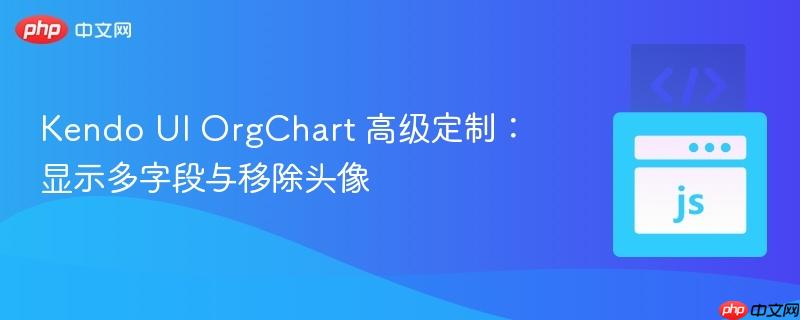
本教程详细介绍了如何利用 kendo ui orgchart 的 `template` 选项,实现对组织结构图节点内容的深度定制。通过自定义 html 模板,您可以轻松展示多个业务字段(如绩效指标),并移除默认的头像显示,从而满足特定的数据可视化需求,提升图表的专业性和信息密度。
Kendo UI OrgChart 是一个功能强大的组织结构图组件,用于以层级结构可视化数据。它默认提供了一种简洁的节点显示方式,通常只包含“姓名”和“职位”两个核心信息,并可能附带一个头像。这种默认配置在许多标准场景下已足够使用。然而,在面对更复杂的数据模型时,例如需要在一个节点中展示多个业务指标或自定义属性,并且可能不需要头像时,就需要进行更深层次的定制。
默认的 Kendo UI OrgChart 节点结构通常是固定的,它通过内部机制绑定数据源中的 name 和 position 字段来显示信息。当您的数据源包含 item_desc、eoy_target、ytd_plan 等多个自定义字段,并且希望将它们全部呈现在组织结构图的每个节点上时,就需要利用 Kendo UI 提供的模板机制。
Kendo UI OrgChart 提供了 template 选项,允许开发者完全控制每个节点(Node)的渲染方式。通过指定一个包含 HTML 结构的字符串作为 template 的值,您可以定义节点内部的任何内容、布局和样式。
在模板字符串中,您可以使用 #: fieldName # 的语法来访问当前节点数据项中的任意字段。例如,如果您的数据项包含 item_desc 字段,您就可以在模板中使用 #: item_desc # 来显示其值。
要实现 Kendo UI OrgChart 节点显示多个自定义字段并移除头像,核心步骤是构建一个包含所有所需字段的 HTML 模板,并将其赋值给 template 选项。
首先,确保您的 JSON 数据源包含了所有需要显示的信息。例如,以下是包含多个业务指标的数据结构:
[
{
"item_id": "195",
"item_desc": "Fuel Cost",
"parent_pi_kode": "193",
"parent_pid_desc": "Blasting Cost",
"eoy_target": 0.2,
"eoy_actual": 0.32,
"ytd_plan": 0.13,
"ytd_actual": 0.14,
"achi_pi": 107.69,
"achi_ia": 0.0,
"achi_ra": 0.0,
"achi_ip": 0.0,
"has_child": true,
"is_expanded": true
},
{
"item_id": "194",
"item_desc": "AN Cost",
"parent_pi_kode": "193",
"parent_pid_desc": "Blasting Cost",
"eoy_target": 0.2,
"eoy_actual": 0.32,
"ytd_plan": 0.1,
"ytd_actual": 0.12,
"achi_pi": 120.0,
"achi_ia": 0.0,
"achi_ra": 0.0,
"achi_ip": 0.0,
"has_child": true,
"is_expanded": true
},
{
"item_id": "196",
"item_desc": "Oil Cost",
"parent_pi_kode": "193",
"parent_pid_desc": "Blasting Cost",
"eoy_target": 0.2,
"eoy_actual": 0.32,
"ytd_plan": 0.08,
"ytd_actual": 0.1,
"achi_pi": 125.0,
"achi_ia": 0.0,
"achi_ra": 0.0,
"achi_ip": 0.0,
"has_child": true,
"is_expanded": true
}
]根据您需要显示的字段,创建一个 HTML 字符串。在这个模板中,我们将移除默认的头像 <img> 标签,并为每个字段创建相应的显示元素,例如 div 或 span。为了提高可读性,可以使用 <label> 或 <strong> 标签来标识字段名称。
<div class='custom-orgchart-node'>
<div class='node-header'>
<strong>#: item_desc #</strong>
</div>
<div class='node-body'>
<p>EOY Target: <span>#: kendo.toString(eoy_target, "n2") #</span></p>
<p>EOY Actual: <span>#: kendo.toString(eoy_actual, "n2") #</span></p>
<p>YTD Plan: <span>#: kendo.toString(ytd_plan, "n2") #</span></p>
<p>YTD Actual: <span>#: kendo.toString(ytd_actual, "n2") #</span></p>
<p>ACHI PI: <span>#: kendo.toString(achi_pi, "n2") #</span></p>
<p>ACHI IA: <span>#: kendo.toString(achi_ia, "n2") #</span></p>
<p>ACHI RA: <span>#: kendo.toString(achi_ra, "n2") #</span></p>
<p>ACHI IP: <span>#: kendo.toString(achi_ip, "n2") #</span></p>
</div>
</div>注意:
在初始化 Kendo UI OrgChart 时,将上述自定义模板字符串赋值给 template 选项。同时,您需要配置 dataSource 和 schema 来正确解析数据。schema.model.id 和 schema.model.parentId 字段是构建层级关系的关键。
$("#orgchart").kendoOrgChart({
dataSource: new kendo.data.OrgChartDataSource({
data: orgChartData, // 您的JSON数据
schema: {
model: {
id: "item_id", // 映射数据中的唯一标识字段
parentId: "parent_pi_kode", // 映射数据中的父节点标识字段
fields: {
item_desc: { type: "string" },
eoy_target: { type: "number" },
eoy_actual: { type: "number" },
ytd_plan: { type: "number" },
ytd_actual: { type: "number" },
achi_pi: { type: "number" },
achi_ia: { type: "number" },
achi_ra: { type: "number" },
achi_ip: { type: "number" }
}
}
}
}),
// 启用展开/折叠功能,如果您的数据有has_child和is_expanded字段
// 这通常由OrgChartDataSource自动处理,但确保数据源配置正确
template: "<div class='custom-orgchart-node'>" +
"<div class='node-header'>" +
"<strong>#: item_desc #</strong>" +
"</div>" +
"<div class='node-body'>" +
"<p>EOY Target: <span>#: kendo.toString(eoy_target, 'n2') #</span></p>" +
"<p>EOY Actual: <span>#: kendo.toString(eoy_actual, 'n2') #</span></p>" +
"<p>YTD Plan: <span>#: kendo.toString(ytd_plan, 'n2') #</span></p>" +
"<p>YTD Actual: <span>#: kendo.toString(ytd_actual, 'n2') #</span></p>" +
"<p>ACHI PI: <span>#: kendo.toString(achi_pi, 'n2') #</span></p>" +
"<p>ACHI IA: <span>#: kendo.toString(achi_ia, 'n2') #</span></p>" +
"<p>ACHI RA: <span>#: kendo.toString(achi_ra, 'n2') #</span></p>" +
"<p>ACHI IP: <span>#: kendo.toString(achi_ip, 'n2') #</span></p>" +
"</div>" +
"</div>"
});为了让自定义节点看起来更美观,可以添加一些 CSS 样式。
.k-orgchart-node {
width: 250px; /* 调整节点宽度以容纳更多信息 */
min-height: 180px; /* 调整节点最小高度 */
box-shadow: 0 2px 5px rgba(0,0,0,0.1);
border-radius: 8px;
overflow: hidden; /* 确保内容不溢出 */
}
.custom-orgchart-node {
padding: 10px;
background-color: #fff;
color: #333;
font-family: Arial, sans-serif;
font-size: 13px;
line-height: 1.4;
}
.custom-orgchart-node .node-header {
background-color: #f0f0f0;
padding: 8px 10px;
margin: -10px -10px 10px -10px; /* 扩展背景到边缘 */
border-bottom: 1px solid #ddd;
font-size: 14px;
color: #0056b3;
}
.custom-orgchart-node .node-header strong {
display: block;
text-align: center;
}
.custom-orgchart-node .node-body p {
margin: 3px 0;
display: flex;
justify-content: space-between;
}
.custom-orgchart-node .node-body span {
font-weight: bold;
color: #007bff;
}将上述 HTML、JavaScript 和 CSS 片段整合到一个页面中,即可看到自定义的 Kendo UI OrgChart。
<!DOCTYPE html>
<html>
<head>
<title>Kendo UI OrgChart 自定义节点</title>
<link href="https://kendo.cdn.telerik.com/2024.1.130/styles/kendo.default-v2.min.css" rel="stylesheet" />
<script src="https://kendo.cdn.telerik.com/2024.1.130/js/jquery.min.js"></script>
<script src="https://kendo.cdn.telerik.com/2024.1.130/js/kendo.all.min.js"></script>
<style>
html, body {
margin: 0;
padding: 0;
height: 100%;
overflow: hidden;
font-family: Arial, sans-serif;
}
#orgchart {
height: 100%;
width: 100%;
margin: 0 auto;
}
.k-orgchart-node {
width: 280px; /* 调整节点宽度以容纳更多信息 */
min-height: 200px; /* 调整节点最小高度 */
box-shadow: 0 2px 8px rgba(0,0,0,0.15);
border-radius: 8px;
overflow: hidden;
background-color: #fff;
border: 1px solid #e0e0e0;
}
.custom-orgchart-node {
padding: 10px;
color: #333;
font-size: 13px;
line-height: 1.4;
display: flex;
flex-direction: column;
height: 100%; /* 确保内部div填充节点高度 */
}
.custom-orgchart-node .node-header {
background-color: #f8f9fa;
padding: 8px 10px;
margin: -10px -10px 10px -10px; /* 扩展背景到边缘 */
border-bottom: 1px solid #dee2e6;
font-size: 15px;
color: #212529;
text-align: center;
font-weight: bold;
}
.custom-orgchart-node .node-body {
flex-grow: 1; /* 让内容区域填充剩余空间 */
display: flex;
flex-direction: column;
justify-content: space-around; /* 均匀分布内容 */
}
.custom-orgchart-node .node-body p {
margin: 2px 0;
display: flex;
justify-content: space-between;
align-items: center;
}
.custom-orgchart-node .node-body p strong {
color: #555;
font-weight: normal;
margin-right: 5px;
}
.custom-orgchart-node .node-body p span {
font-weight: bold;
color: #007bff;
white-space: nowrap; /* 防止数字换行 */
}
</style>
</head>
<body>
<div id="orgchart"></div>
<script>
$(document).ready(function () {
var orgChartData = [
{
"item_id": "193", // 假设这是一个根节点或父节点
"item_desc": "Blasting Cost",
"parent_pi_kode": null, // 根节点没有父节点
"eoy_target": 0.6,
"eoy_actual": 0.96,
"ytd_plan": 0.31,
"ytd_actual": 0.36,
"achi_pi": 116.13,
"achi_ia": 0.0,
"achi_ra": 0.0,
"achi_ip": 0.0,
"has_child": true,
"is_expanded": true
},
{
"item_id": "195",
"item_desc": "Fuel Cost",
"parent_pi_kode": "193",
"parent_pid_desc": "Blasting Cost",
"eoy_target": 0.2,
"eoy_actual": 0.32,
"ytd_plan": 0.13,
"ytd_actual": 0.14,
"achi_pi": 107.69,
"achi_ia": 0.0,
"achi_ra": 0.0,
"achi_ip": 0.0,
"has_child": true,
"is_expanded": true
},
{
"item_id": "194",
"item_desc": "AN Cost",
"parent_pi_kode": "193",
"parent_pid_desc": "Blasting Cost",
"eoy_target": 0.2,
"eoy_actual": 0.32,
"ytd_plan": 0.1,
"ytd_actual": 0.12,
"achi_pi": 120.0,
"achi_ia": 0.0,
"achi_ra": 0.0,
"achi_ip": 0.0,
"has_child": true,
"is_expanded": true
},
{
"item_id": "196",
"item_desc": "Oil Cost",
"parent_pi_kode": "193",
"parent_pid_desc": "Blasting Cost",
"eoy_target": 0.2,
"eoy_actual": 0.32,
"ytd_plan": 0.08,
"ytd_actual": 0.1,
"achi_pi": 125.0,
"achi_ia": 0.0,
"achi_ra": 0.0,
"achi_ip": 0.0,
"has_child": true,
"is_expanded": true
}
];
$("#orgchart").kendoOrgChart({
dataSource: new kendo.data.OrgChartDataSource({
data: orgChartData,
schema: {
model: {
id: "item_id",
parentId: "parent_pi_kode",
fields: {
item_desc: { type: "string" },
eoy_target: { type: "number" },
eoy_actual: { type: "number" },
ytd_plan: { type: "number" },
ytd_actual: { type: "number" },
achi_pi: { type: "number" },
achi_ia: { type: "number" },
achi_ra: { type: "number" },
achi_ip: { type: "number" }
}
}
}
}),
template: "<div class='custom-orgchart-node'>" +
"<div class='node-header'>" +
"#: item_desc #" +
"</div>" +
"<div class='node-body'>" +
"<p><strong>EOY Target:</strong> <span>#: kendo.toString(eoy_target, 'n2') #</span></p>" +
"<p><strong>EOY Actual:</strong> <span>#: kendo.toString(eoy_actual, 'n2') #</span></p>" +
"<p><strong>YTD Plan:</strong> <span>#: kendo.toString(ytd_plan, 'n2') #</span></p>" +
"<p><strong>YTD Actual:</strong> <span>#: kendo.toString(ytd_actual, 'n2') #</span></p>" +
"<p><strong>ACHI PI:</strong> <span>#: kendo.toString(achi_pi, 'n2') #</span></p>" +
"<p><strong>ACHI IA:</strong> <span>#: kendo.toString(achi_ia, 'n2') #</span></p>" +
"<p><strong>ACHI RA:</strong> <span>#: kendo.toString(achi_ra, 'n2') #</span></p>" +
"<p><strong>ACHI IP:</strong> <span>#: kendo.toString(achi_ip, 'n2') #</span></p>" +
"</div>" +
"</div>"
});
});
</script>
</body>
</html>以上就是Kendo UI OrgChart 高级定制:显示多字段与移除头像的详细内容,更多请关注php中文网其它相关文章!

每个人都需要一台速度更快、更稳定的 PC。随着时间的推移,垃圾文件、旧注册表数据和不必要的后台进程会占用资源并降低性能。幸运的是,许多工具可以让 Windows 保持平稳运行。

Copyright 2014-2025 https://www.php.cn/ All Rights Reserved | php.cn | 湘ICP备2023035733号